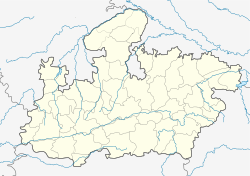Satna
|
Satna सतना |
|
|---|---|
| Location in Madhya Pradesh, India | |
| Coordinates: 24°10′N 80°50′E / 24.16°N 80.83°ECoordinates: 24°10′N 80°50′E / 24.16°N 80.83°E | |
| Country |
|
| State | Madhya Pradesh |
| Region | Baghelkhand |
| District | Satna |
| Government | |
| • Type | Mayor–Council |
| • Body | Satna Municipal Corporation |
| • Mayor | Smt. Mamta Pandey |
| • DM | Shri Naresh Kumar Pal |
| • MP | Shri Ganesh Singh |
| • MLA | Shri Shankar Lal Tiwari |
| Area | |
| • Total | 7 km2 (3 sq mi) |
| Elevation | 415 m (1,362 ft) |
| Population (2011) | |
| • Total | 283,004 |
| Languages | |
| • Official | Hindi |
| • Local | Bagheli |
| Time zone | IST (UTC+5:30) |
| PIN | 485001 |
| Telephone | 07672 |
| Vehicle registration | MP-19-XXXX |
| Website | satna |
Satna is a city in the Satna District (सतना) of the Indian state of Madhya Pradesh, which shares a border with neighboring Uttar Pradesh. The city is a municipal corporation within the district, and the home of its administrative headquarters.
At nearby Bharhut are the remains of a 2nd-century BC Buddhist stupa, first discovered in 1873 by renowned archaeologist Alexander Cunningham; most of the finds from this site were sent to the Indian Museum.
The Mahabharata associates this site with rulers of the Haihaya, Kalchuri or Chedi clans.
The chiefs of Rewash, descended from Baghel Rajputs (who were in turn descended from the Solanki), ruled over Gujrat from the tenth to the thirteenth century. Vyaghra Deo, brother of the ruler of Gujrat, is said to have made his way into northern India about the middle of the thirteenth century and obtained the fort of Marpha, 18 miles north-east of Kalinjar.
His son Karandeo married a Kalchuri (Haihaya) princess of Mandla and received in Dowry the fort of Bandhavgarh (now in the tehsil of the same name in Shahdoldistrict), which, until its destruction in 1597 by Akbar, was the Baghel Capital. In 1298, general prince Ulugh Khan, acting under order of his brother Sultan Alauddin Khilji, drove the last Baghel ruler of Gujrat out of his country. This is believed to have caused a considerable migration of the Baghels to Bandhavgarh.
...
Wikipedia

